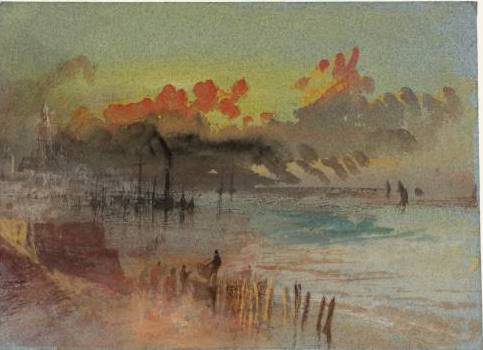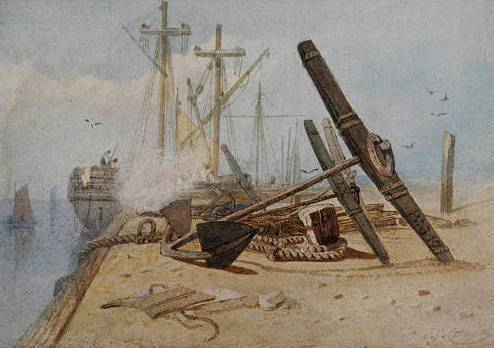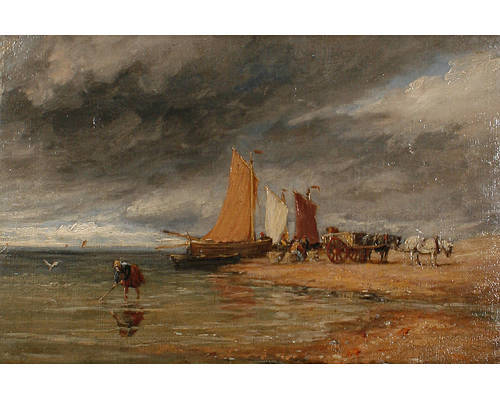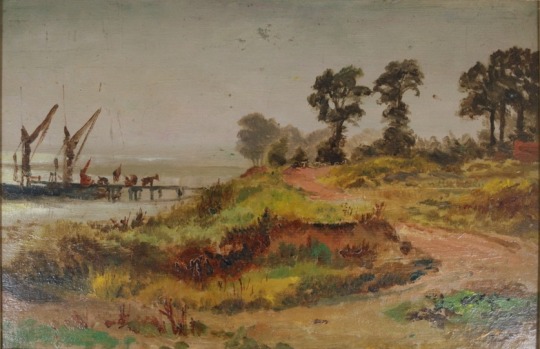Photo

Edward Williams (1782-1855), Near Yarmouth Roads. A glorious 'moonlight', worthy of John Crome or his son John Berney Crome, and a classic 'Norwich School' Painting, even though Williams himself wasn't an East Anglia artist.
28 notes
·
View notes
Note
WHAT MAKES YOU FEEL BETTER WHEN YOU ARE IN A BAD MOOD?
Family, music, sunshine...and good paintings!xxx
0 notes
Photo

Edward Robert Smythe, a fisherman's family awaiting his safe return at Pakefield, Suffolk.
20 notes
·
View notes
Photo

Thomas Smythe (1825-1906), Edward Smythe's brother, watercolour of Shotley Beach looking towards Harwich.
14 notes
·
View notes
Photo

Edward Robert Smythe (1810-99), Ipswich painter, Felixtowe, Suffolk.
26 notes
·
View notes
Photo

Ron Holmes (b. 1945), Blackwater Creek, Essex.
8 notes
·
View notes
Photo

J.M.W.Turner, Sunrise at Margate, watercolour sketch late 1830s.
47 notes
·
View notes
Photo

J.M.W.Turner (1775-1851), Margate, Kent. Turner spent a considerable amount of time sketching and painting this part of the Kent coast.
21 notes
·
View notes
Photo

Thomas Smythe (1825-1906), Ipswich painter, brother of the prolific painter Edward Robert Smythe (1810-99). This is a simply breathtaking oil sketch of Dunwich beach, Suffolk. Dunwich, now a village, is the ghost city of the English east coast: formerly, some 15 centuries ago, the proud capital of East Anglia, it has been inexorably devoured by coastal erosion. William Camden, in his Britannia (1607), translated by Philemon Holland, says of the town's decay: 'But now by a certaine peculiar spite and envie of Nature , that suffereth the greedy sea to have what it will and encroch still without all end, the greatest part thereof is violently carried away with the waves, and by reason that the Bishops many yeares agoe translated their seat to another place, it lieth (as it were) desolate'.
9 notes
·
View notes
Photo

Quayside. A typically detailed and beautifully rendered John Sell Cotman (1782-1842) watercolour.
26 notes
·
View notes
Photo

John Sell Cotman (1782-1842), Norwich School, painted largely in watercolour. This is a superbly brooding coastal oil by him, probably east coast.
9 notes
·
View notes
Photo

Coast Scene with Breaking Cloud Sun, John Constable c1830
Possibly the English south east coast, given the paintings of Brighton etc. But Constable also worked around Yarmouth. Anyway, it's superb.
49 notes
·
View notes
Photo

The earliest I have so far found of Robert Gallon's Leigh oil sketches. This one is called 'Between Southend and Leigh', and was painted on 14 September 1886. (Full information on reverse of original.)T his is a preparatory sketch for the oil on canvas in the Wiki gallery as linked, and entitled simply 'A Glimpse of the Sea'.
3 notes
·
View notes
Photo

Detail of the Gallon, 7 September 1888 sunset oil. The subtlety of the brushwork, as he dashes down the impression before it fades, is wonderful.
8 notes
·
View notes
Photo

On 7 September 1888, Robert Gallon had sat down at almost the same spot as in the previous painting of Leigh on Sea, and captured the fleeting light of a less sombre evening in this lovely oil sketch.
6 notes
·
View notes
Photo

A moody oil sketch on board by Robert Gallon (1845-1925), of Leigh on Sea, Essex, on the north coast of the Thames, where the river opens into the North Sea. Gallon is perhaps best known for his 'realistic' landscapes of Surrey and the inland Thames, which often tend to Victorian rural idealism, ignoring the bleak and poverty-stricken lives that were so often lived behind the picturesque cottage walls. In this small on-the-spot oil sketch (some 7 by 12 inches), he lets out the painterly self that isn't at the beck and call of patrons: the world is beautiful but bleak, and land and sky reflect each other in an evening darkness that belongs very much to the marsh and river world of Dickens's Great Expectations of some 30 years earlier.
6 notes
·
View notes